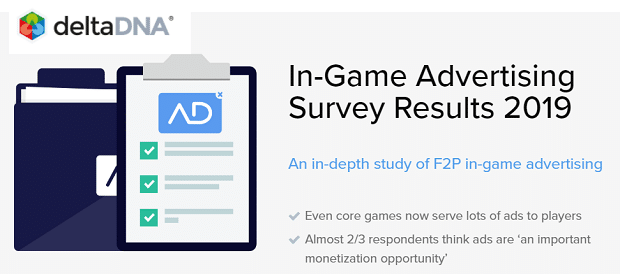
The fifth annual In-Game Advertising Study, released by deep-data analytics and player management company, deltaDNA, finds that 94% of Free-to-Play (F2P) games now feature some form of in-game advertising (up from 87% in 2018). While the number of developers making between 40-100% of their revenue from ads has increased by 21% year on year.
The study, which is based on the experiences and opinions of hundreds of game developers, suggests that the ‘cautious’ and ‘experimental’ phase of in-game advertising could be coming to an end, with the number of game makers feeling
‘confident’ about their approach to ads up 60% in just twelve months.
Developers are becoming increasingly competent when it comes to balancing ads and In-app Purchases (IAP) in a way that preserves the player experience. As a result, 30% of developers are now showing five or more ads per session (compared to just 20% in 2018) while the number of developers choosing not to show any ads has fallen by almost a third to just 10%.
This confidence also extends to ad formats, with 68% now using more than one ad format within their games (up from 56% in 2018), while 33% use three or more different types of advertising, a rise from 20% the previous year.
But it’s not just casual games where ads are flourishing. The number of core games generating 81-100% of their revenue from ads has increased by 7% in twelve months, as developers becoming increasingly convinced of the legitimacy of ads as a vital revenue stream.
Other key findings include:
- Rewarded video ads continue to go from strength to strength and are now deployed within 82% of games (up from 65% last year), ahead of interstitial video ads (57%) and banners (34%). Playable ads are now used in 19% of games, down from 21% last year.
- The number of respondents who identify in-game ads as an ‘important monetization opportunity’ has grown from 59% in 2018 to 64% in 2019, while only 15% believe ads scare off potential payers.
- When it comes to setting the frequency of ads in a game, the most common concerns among developers are increased player churn (30%), lower levels of player enjoyment (27%) and impact on IAP revenue (16%).
- Almost a third of developers (28%) don’t evaluate the return they get from UA spend, while the most common form of evaluation (31%) is to compare the CPI from UA campaigns.
Mark Robinson, GM, deltaDNA, said: “In the five years that we’ve been running this study, we’ve seen attitudes towards in-game advertising evolve significantly, to the point where ads now feature in almost all casual games and increasingly in core games.
“By using analytics and A/B testing, game developers have been able to move beyond the retention concern of previous years by integrating in-game advertising as a key part of the player experience.
“This has given developers the confidence to use a wider range of ad formats and show more ads per session, which is why the number of games making the majority of revenue from ads continues to grow.”
